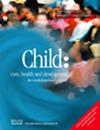Parental Migration and the Suspected Developmental Delay of Left-Behind Children in Rural China
Abstract
Background
There are estimated 41.77 million left-behind children (LBC) in rural China, among whom 14.26 million are under the age of 5 years. However, limited research exits on how different parental migration status affects the early development of rural LBC. The purpose of this study is to examine early child development of previous-left-behind children (PLBC), children with single parent migrating (SLBC), children with both parents migrating (BLBC) as compared to never-left-behind children (NLBC). This study also attempts to explore the factors affecting the early development levels of four types of rural children.
Methods
A questionnaire survey was conducted among 1614 child caregivers in Nanling County, Anhui Province. Ages & Stages Questionnaires–Chinese version (ASQ-C) was conducted to measure suspected developmental delay (SDD) of rural children. The parenting knowledge, depressive symptoms and parenting behaviours of caregivers were measured using the Knowledge of Infant Development Inventory-P (KIDI-P), Beck Depression Inventory-II (BDI-II) and Family Care Indicators (FCI). After controlling for the sociodemographic characteristics of children and primary caregivers, binary logistic regression was employed to assess the association between various categories of rural children and early developmental delays.
Results
The results showed significant differences in total SDD among the four types of rural children (p < 0.01), and the risk of total SDD in BLBC was 1.78 times that of NLBC [OR = 1.78, 95% CI (1.23–2.60), p < 0.01]. The study showed that caregivers' parenting knowledge [0.54, (0.31–0.93), p < 0.05], parenting behaviour [0.86, (0.80–0.92), p < 0.001] and caregiver depressive symptoms [1.51, (1.14–1.99), p < 0.01] were strongly associated with total SDD.
Conclusion
In this study, BLBC exhibit the most pronounced early developmental delay. Additionally, PLBC who have experienced being left behind also face disadvantages. The findings provide valuable insights into LBC across various parental migration contexts and contribute to a better understanding of the risk factors of early childhood development. Correspondingly, the study emphasizes that family, society and government should formulate corresponding intervention measures to reduce the risk of early development for rural children.

 求助内容:
求助内容: 应助结果提醒方式:
应助结果提醒方式:


